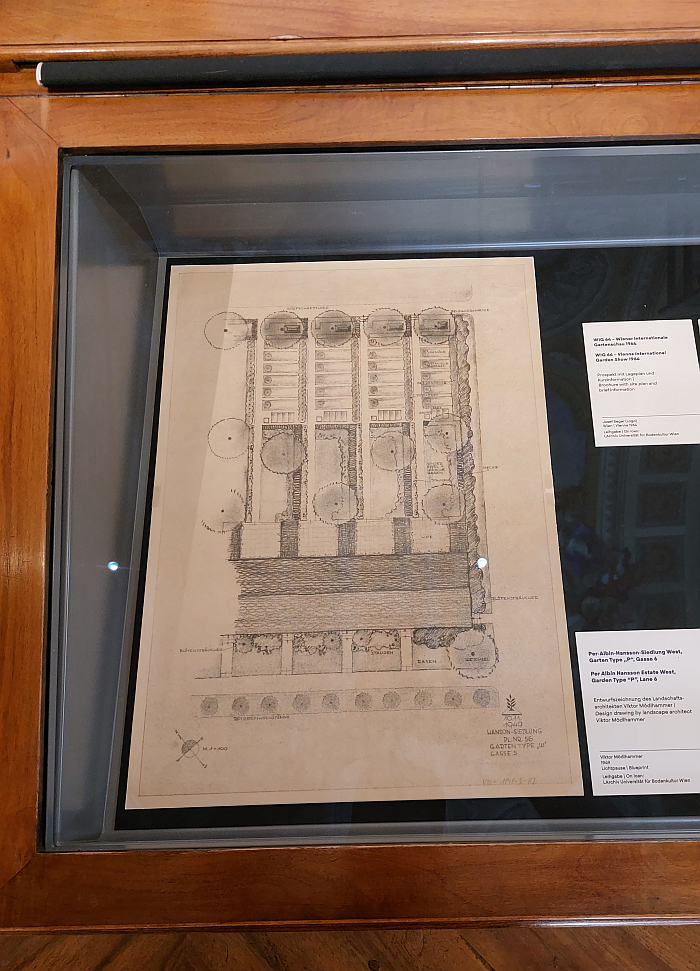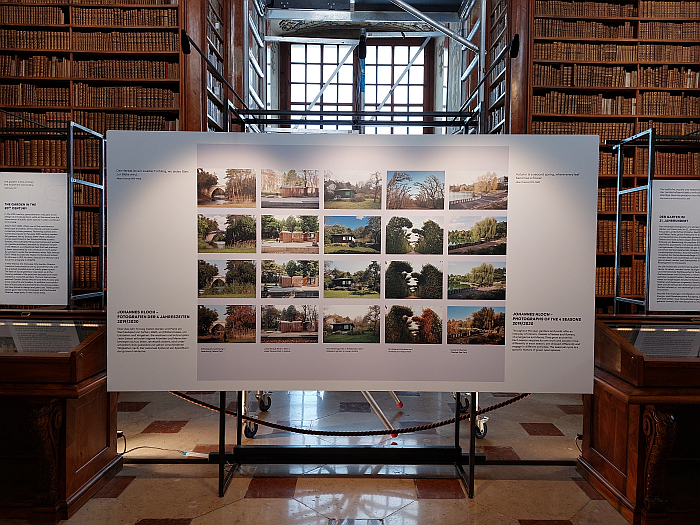Of Gardens and People. Designed Nature, Art and Landscape Architecture at the Austrian National Library, Vienna
Much as the (hi)story of architecture is also a chronicle of developments and changes in the social, cultural, economic, ecological, technical, et al realities of any given region, so to is the (hi)story of a region’s parks and gardens and urban green spaces.
Whereby the (hi)story of the latter is much less often popularly employed in studying and interpreting and learning from the (hi)story of a region than the former.
With the showcase Of Gardens and People. Designed Nature, Art and Landscape Architecture the Austrian National Library, Vienna, allow for reflections on gardens and parks throughout (hi)story and in doing encourage us all to take them as seriously as we do the architecture amongst which they invariably stand…….
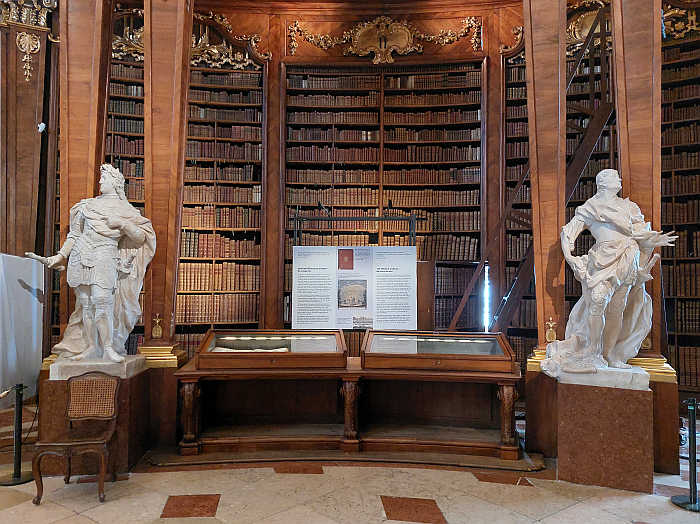
Of Gardens and People. Designed Nature Art and Landscape Architecture, Austrian National Library, Vienna
While there are admittedly, on first reflections, more obvious locations to stage an exhibition on the place, role, function of urban green spaces and on our relationships with urban green spaces than a library, and certainly a lot of apparently more obvious locations to stage such an exhibition in Vienna, than in a library, and for all in the so-called Prunksaal, State Hall, of the Austrian National Library, a space which although containing, arguably, as much wood as the Wienerwald its presence in exquisitely and ostentatiously carpented forms does tend to mock nature rather than embrace it; however, given the depth and range and scope and age of the collection of the Austrian National Library, and the very close associations of that collection with the Habsburg dynasty and their contemporaries, it is perhaps, on longer reflection, one of the more appropriate locations in Vienna for initiating a discussion on the place, role, function of urban green spaces, and thus one of the more appropriate location for such a showcase.
A showcase which in the course of its narrative takes you from the 16th century and the unyielding geometry of the gardens of the Renaissance to our contemporary 21st century parks and gardens with their open questioning of geometry; a narrative explored more thematically than chronologically, although the latter is very present, and which in addition to gardens and parks also takes time to reflect on both garden designers/architects and on gardeners, and thus a reminder of two of the three People of the exhibition title who make any garden that which it is; whereby the inclusion of gardeners is particularly pleasing, being as they are a component of the triumvirate all too frequently and unfairly overlooked in popular appreciations of parks and gardens. But who are every bit as important as the other two components. We’ll meet the third of the three People in due time.
A showcase which, being as it is a library showcase in a library, is primarily a paper based presentation, featuring as it does a great many plans, sketches, engravings, photos, and books, frozen in glass vitrines. ¯\_(ツ)_/¯ And as an Austrian National Library presentation, primarily an Austrian paper presentation, introducing in the course of its narrative green spaces such as, for example, and amongst others, the 17th century Hofgarten in Salzburg, the ‘English’ landscape garden developed in the second half of the 18th century at Neuwaldegg, on the edge of the contemporary Vienna, or the so-called Rosenbaum garden, Paradeisgartl and Wasserglacis as examples of 19th century public parks in Vienna in contrast to the private dominions of the Habsburg’s and their contemporaries.
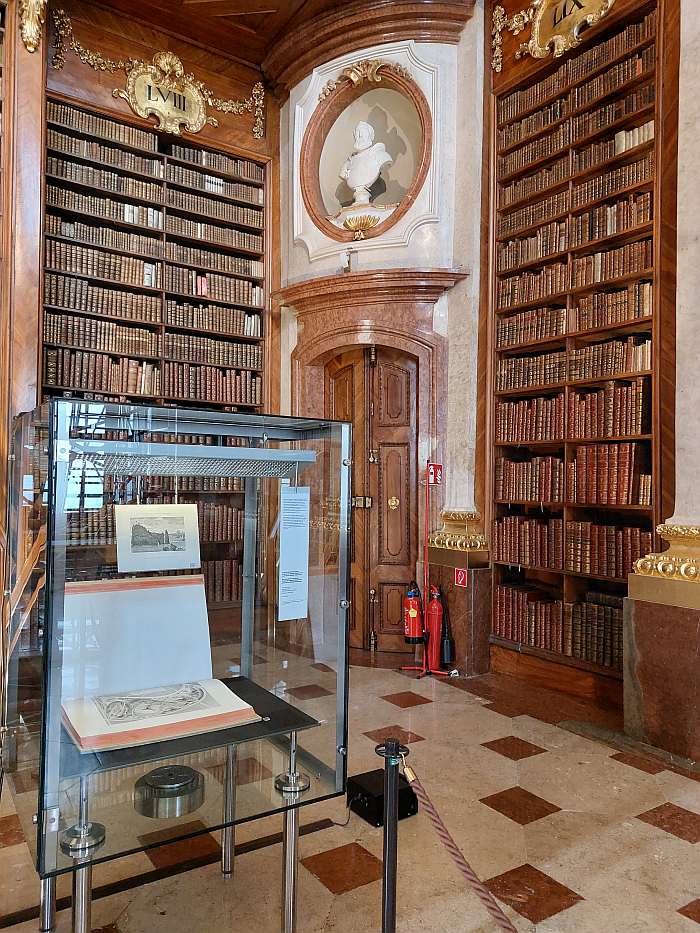
A late 19th century engraving of Parc des Buttes-Chamont, Paris, by Adolphe Alphanda nd Jean-Pierre Barillet-Deschamps, as seen at Of Gardens and People. Designed Nature Art and Landscape Architecture, Austrian National Library, Vienna
But a presentation which doesn’t ignore the international context, or more accurately the European context, Of Gardens and People is very much a Euro-centric presentation, one that doesn’t make any real effort to explore gardens outwith Europe, in many regards the more honest title would be Of European Gardens and European People, a point to which we shall return… a presentation which doesn’t ignore the European context, making note of, for example, and amongst many others, Vrchlického sady, Prague, Stowe House, England, Versailles, invariably one could add, the Schlossgarten in Hildburghausen with its, as can be seen in a depiction from ca 1720, myriad themed fountains. Or the ever enjoyable Bad Muskau park by the ever outrageous Fürst Pückler, a discussion on Bad Muskau which includes a sketch of the Fürst’s planting plan which in its colour coding and allusions more to abstract art than garden planning reminds very much of the planning visualisations of a Piet Oudolf as presented in Garden Futures. Designing with Nature at the Vitra Design Museum, Weil am Rhein.
And being as it is a library presentation, in a library, it also feature numerous books on gardens, gardening, garden design, etc published over the centuries including, for example, Antoine-Joseph Dezallier’s 1709 La théorie et la pratique du jardinage, Gustav Meyer’s 1860 Lehrbuch der schönen Gartenkunst, Marie Luise Gothein’s Geschichte der Gartenkunst from 1914, or, and looking in the other direction, Leberecht Migge’s 1913 work Die Gartenkultur des 20. Jahrhunderts, the latter reminding, as is all too easily forgotten today, that gardens and parks were key components of inter-War Modernist urban planing propositions. And also explores and considers parks and gardens in literature, of all types, specifically making reference to, for example, Jean-Jacques Rousseau’s Julie ou la Nouvelle Héloïse, Adalbert Stifter’s Nachsommer or Viennese Laupoet Ernst Jandl’s 1970 poem da ist ein garten, the last not being something we can image that would have been well received at the Habsburg court. Had it survived until 1970. And reflections on literary gardening, gardens in literature, to which we’ll add the image evoked to us in Of Gardens and People, through an 1827 etching of the greenhouse at the Schwarzenberg garden, of Saccard’s fateful conservatory in La Curée. Just one Émile Zola’s many uses of gardens, parks and greenery as evocation and symbolism.
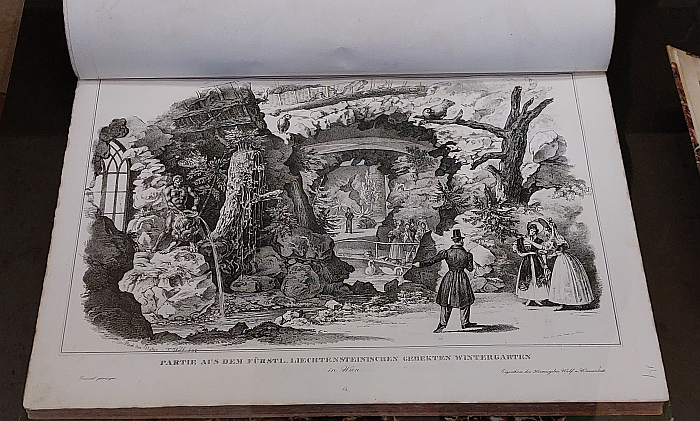
The greenhouse of the Schwarzenberg garden, Vienna during the 1827 Plant Exhibition, as seen at Of Gardens and People. Designed Nature Art and Landscape Architecture, Austrian National Library, Vienna
While much of what Of Gardens and People does isn’t particularly new or revolutionary, the progressions in positions and approaches to garden design from the 16th century to today, and the discourses and debates that accompanied those developments, are well documented and regularly discussed; the context in which the presentation is made does allow for access to insights and reflections that go beyond that progression per se, and which in doing so help allow for considerations of gardens and parks as more than flora and fauna. And no, by “context” we don’t mean on account of the ostentatious splendour of the Prunksaal.
Much more, for example, the images and discussions of the Habsburgs and their ilk in their parks/gardens, the images and discussions of the cultural elite of late 19th/early 20th century Vienna in their gardens, the images and discussions of the late 18th century playground in the garden of Hohenheim, near Stuttgart, or the early 19th carousel in Arlesheim landscape garden near Basel, and which both very much reminding us of the swings that once graced the colonnades of the Lustgarten at Schloss Pillnitz, Dresden, as deliciously decadent misappropriations of the vocabulary of the formal garden, helping reinforce that gardens and parks have long been, arguably have always been, important locations for staging. Not only, over the centuries parks and gardens have been locations for a great many activities and expressions, but staging has, arguably, has always been an important function.
And which brings us to that third group of People who define gardens: the human users. For without humans parks and gardens don’t actually exist. Not just that gardens and parks are artificial, are creations of human society, have arisen from the desires and requirements of human society and wouldn’t exist as physical realities without human intervention; but parks and gardens need humans to populate them in order to be: It’s humans and human activity that enable parks and gardens to be more than invented physical spaces and to become not only cultural locations with which we identify, but also to become intangible places in our existence and thereby allow us to interact with them, allow them to affect us, act upon us. Allows gardens and parks to take on roles and functions beyond that which they offer and supply physically. Humans not only invented parks and gardens as nouns, it’s humans who enabled them to become adjectives. And verbs.
Thoughts which flow very neatly into the myriad differentiated reflections Of Gardens and People enables on gardens and the passage of time, on how not only parks and gardens have changed with the passage of time, but how relationships with parks and gardens have changed with the passage of time.
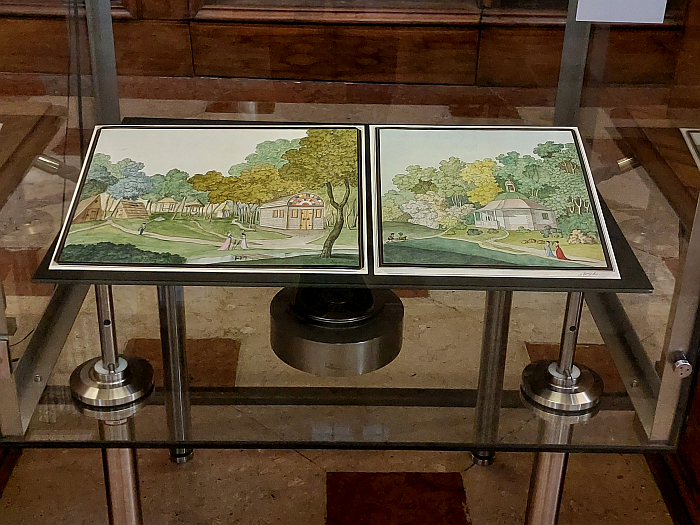
Early 19th century watercolours of Schlosspark Laxenburg by Erzherzogin Maria Clementine, as seen at Of Gardens and People. Designed Nature Art and Landscape Architecture, Austrian National Library, Vienna
Thoughts on changes over time which allows, for example, access to reflections on gardens and parks during the Covid years, and the manner in which Covid changed relationships and appreciations.
On the one hand those who had a private garden we’re, without question, the better placed individuals during the many lockdowns, a nice reminder that today access to a private green space is as much a luxury and a privilege as it was when the Habsburgs called half of Europe their garden. For everyone else there are parks, publicly accessible green spaces which during the Covid years became important institutions for a community; ceased to be just green space in the vicinity that (invariably) were regularly ignored and (often) allowed to decay, and became an actual asset, arguably that thing that modernist urban planners and architects sought to make them, before the reality of every higher density housing in the post-War years made parks expendable, quickly sacrificed when new housing was needed. With the associated altering of the popular perspective on urban green spaces. Covid reminded us all they aren’t. The question is will that lesson filter on through to future public urban planing decisions, or will building developers have the say.
Or parks and gardens and time as approached via the conduit of the curators comments about this or that garden having being, as it were, lost in centuries past through redevelopment from one fashionable design concept to another fashionable design concept, and which, certainly for us, tends to reinforce our reflections from Plant Fever. Towards a Phyto-centred design at Schloss Pillnitz, Dresden, that in an age of climate emergency we need to seriously question the resources employed to preserve and perpetuate historic parks and gardens in their historic guises, rather than transforming them, allowing them to transform, into novel spaces reflective of and responsive to the contemporary realities… yes in a city like Vienna which depends on tourists gazing on unchanging historic buildings and spaces, such a suggestion can be considered sacrilege, but we shouldn’t shy away from suggesting it. And certainly not when one is round the corner from Adolf Loos 1910 so-called ‘eyebrowless house’ whose bare, ornament free facade was considered sacrilege in itself. Before it came banally normal. Or indeed shy away from suggesting such when Of Gardens and People makes clear that back in the day parks and gardens were continually and regularly re-imagined; weren’t the scared relics we consider them today, weren’t reflections of times past, unless of course that is they were actively designed as romantic, romanticised pasts, but were contemporary spaces. Shouldn’t ours be as well? Is that not one of the things the (hi)story of parks and gardens informs us? Parks and gardens don’t actually exist, it’s humans and human society that create and define them. Back in the day, as Of Gardens and People, helps elucidate, it was the ruling elite who defined gardens and parks physically and metaphysical, who constructed parks and gardens as tangible and intangible spaces, over the centuries those duties have increasingly become the task of all, or at least are open to all, but how many of us contribute? And what if more of us did?
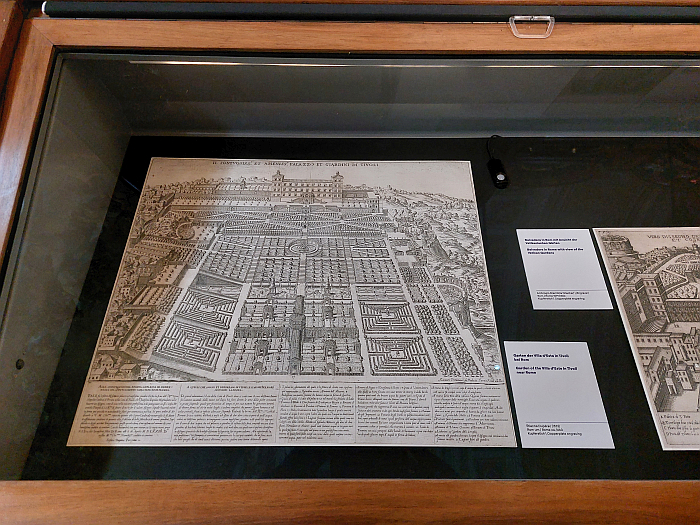
An engraving of the 16th century garden of the Villa d’Este in Tivoli near Rome by Étienne Dupérac, as seen at Of Gardens and People. Designed Nature Art and Landscape Architecture, Austrian National Library, Vienna
In addition, Antoine-Joseph Dezallier’s 1709 opinion that “a garden should not appear dreary and gloomy due to too many shady elements”, may nor not be in itself valid as a position, but does help highlight that going forward we will very much need gardens with ever more “shady elements” if we’re going to cope with the ever warmer climate reality we’re going to face, regardless of what right wing politicians tell you. And something we all learned from Hot Cities: Lessons from Arab Architecture at the Vitra Design Museum Gallery, or would all have learned had the Vitra Design Museum not pulled the showcase, the archive, early in the face of Der Spiegel’s fury; for despite the many, very real, problems of Hot Cities, if you took the time to work through what was there, its strong focus on the importance of appropriately, functionally, designed and developed green spaces as an important tool to help one live more pleasantly in hot cities is and was an lesson we in Europe definitely need to learn. And thoughts on Europeans learning from non-Europeans that helps underscore the aforementioned Euro-centric focus of Of Gardens and People; a focus which although understandable given the very real limits of space in the Prunksaal, is unfortunate, and arguably something that the library of the Habsburg’s, an Empire who, as with all European Empires, spread in many directions, would be a position to do differently. And is certainly something to be remembered when viewing Of Gardens and People: that what is being told isn’t the whole truth, only the European version of the truth. As so oft in the (hi)story of human society.
While the juxtaposition of images of gardeners from the 1960s and 2010s, and the historic images of gardeners undertaking tasks familiar to contemporary gardeners, forces one question what has changed in the gardener’s lot over the centuries, save the introduction of multi-function clothing and safety shoes. Today we have alternatives previous generations didn’t, today we can do things differently, we have novel technological and conceptual possibilities, why don’t we use them in our parks and gardens? Why do gardeners still spend their days on their knees weeding?
And through forcing such questioning, also in context of the brief introductions to contemporary projects which seek to work more with the natural world than to tame and master and dominate it as the garden designers at the start of Of Gardens and People unquestionably did, projects which in addition allow one to appreciate that the formal parks and gardens of yore are increasingly being joined by much less formal urban green spaces of numerous ill defined kinds, a development that we imagine would be very much meet the approval of a Lucius Burckhardt, and which if followed could, arguably, see us move away from the unresponsive historic gardens frozen in time like plans, sketches, engravings, photos, and books in glass vitrines while social, cultural, economic, ecological, technical, et al realities continually evolve and develop, Of Gardens and People is in addition to being a succinct journey through the centuries past of gardens and gardening (hi)story, also very much a space for reflections on the centuries of gardens, parks and urban green spaces still to come.
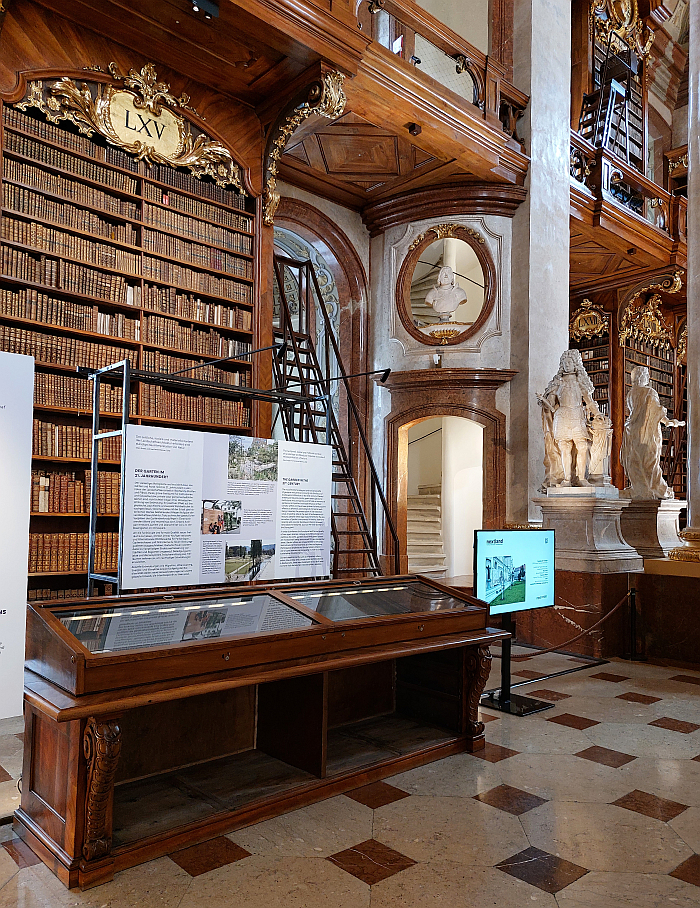
An introduction to the gardens of the 21st in the 18th century ostentation of the Austrian National Library’s Prunksaal, as seen at Of Gardens and People. Designed Nature Art and Landscape Architecture, Austrian National Library, Vienna
Beyond parks and gardens per se being as it is, on one level, a tour from the private estates of the Habsburgs over the rise of civic Vienna with its public parks, on to the gardens of the early 20th century Vienna of Klimt, Wittgenstein, Moser, Mahler et al, to the green spaces of the post-War Rote Wien and ever further to contemporary 21st century gardens, Of Gardens and People is a journey through the (hi)story of Vienna as much as through the (hi)story of gardens, and as such offers an alternative approach to viewing the city, one that doesn’t exist in guide books, for which there is no Hop On-Hop Off tour, and also no established tourist gaze. Thus a viewing of Vienna you’ll have to work out for yourself. And a framework via which to view Vienna that is, inarguably, and recommendably, readily extendable to other cities.
Whereby in context of being a tour through the (hi)story of Vienna, unless we missed it, Of Gardens and People makes no reference to Vienna’s Siedlerbewegung of the early 20th century, which is a genuine shame, and we’d argue genuine omission; and that not least because in their use of their gardens for food production and for relaxation, and in the manner in which they created their gardens themselves, initially through squatting and later with with official recognition, they are important moment in the development of gardens and parks in Vienna. If, admittedly, arguably, a moment not as politely middle and upper class as the many other the moments presented in Of Gardens and People. Not that that’s an accusation. Although could be indicative of a curatorial perspective.
Similarly the curators sadly also couldn’t find room for reflections on connections between gardens/park and Imperialism and Colonialism, although we’re certain there must be a myriad references in such an expansive Imperial library; and is again a genuine shame and omission because Imperialism, Colonialism, and the other episodes in the exploitation of the globe by Europeans are and were very important in the development of the parks and gardens of Europe, and without which our contemporary parks and gardens would be very different places. And many of our plants and trees would have very different names. And which is without question a component garden (hi)story, a component of gardens and people that is in need of a more detailed and honest telling; and a telling which, as said, we’d imagine the Austrian National Library is invariably in a very good place to contribute to.
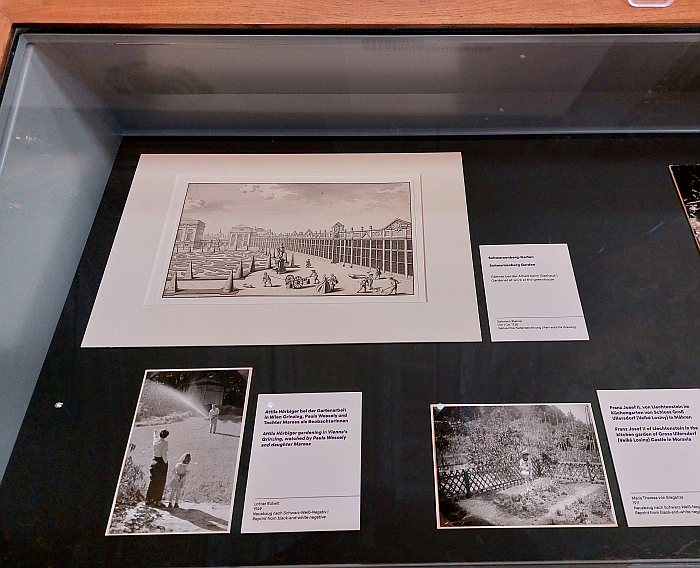
Historic depictions of gardeners professional and amateur at work, including bottom right a young Franz Josef II, as seen at Of Gardens and People. Designed Nature Art and Landscape Architecture, Austrian National Library, Vienna
As a vitrine and poster exhibition Of Gardens and People is a lot to read, but it is being presented in a library, but isn’t difficult, nor time consuming to read; the accessible and readily comprehensible bilingual German/English texts in conjunction with the many images and photos guides you gently through the material and through the themes.
Apropos ‘guides’.
Presented as it is the Prunksaal does bring with it the very slight disadvantage, irritation, that as you try to concentrate on that presented you are continually distracted and obstructed by guides herding their groups of tourists, all tuned to their ear pieces and intent only on taking as many photos as possible, and thus oblivious to all and everything around them, existing in their own bubble. And you also have to contend with groups of school pupils apparently involved in a competition to see who look most disinterested in a space whose outrageous Prunk can’t fail to attract your curiosity. Which ain’t good, isn’t conducive to mediating information, but it’s a tourist attraction at the heart of Imperial Vienna ¯\_(ツ)_/¯
However, don’t let yourself get put off, stick with it, and with time you do you get use to ebb and flow, and develop strategies to avoid the worst of the inconvenience, and once you do you discover a presentation that for all the very necessary abbreviation of its presentation in terms of subject matter and objects, there are only so many glass vitrines that can be placed in the Prunksaal, and an abbreviation which does leave you to do a lot of the work, instigate a lot of the discussions yourself, which isn’t a complaint, far from it, it’s good to be made to work in an exhibition, enables Of Gardens and People to allow for informative and instructive thoughts and reflections on not just gardens but on people, on human society, on cities, and on the place, functions and roles of parks and gardens past present and future.
And having reflected on urban green spaces in the tourist gaze confirming sanctity and ostentation of the Austrian National Library’s Prunksaal, the obvious thing to do, the necessary thing to do, is to take the thoughts began there out into the green spaces of Vienna.
Of Gardens and People. Designed Nature, Art and Landscape Architecture is scheduled to run the Austrian National Library, Josefsplatz 1, 1010 Vienna, until Sunday November 5th.
Full details can be found at www.onb.ac.at
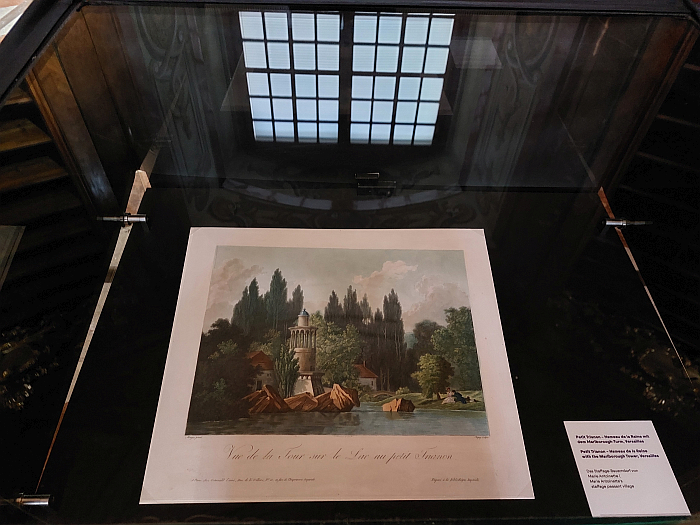
The Petit Trianon – Hameau de la Reine and Marlborogh Tower, Versailles, as seen at Of Gardens and People. Designed Nature Art and Landscape Architecture, Austrian National Library, Vienna
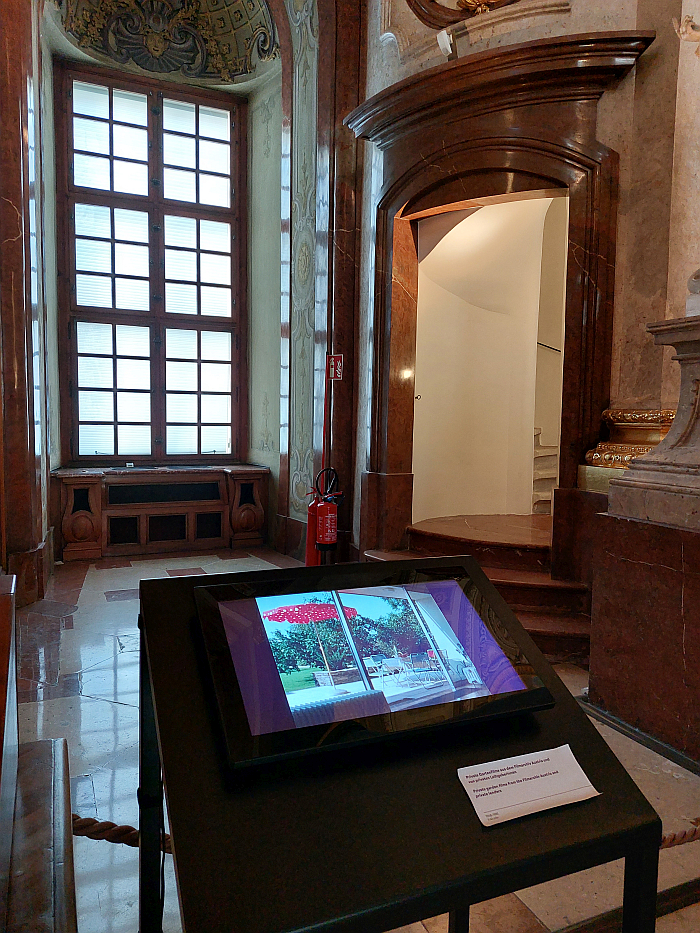
Videos of Austrians enjoying their private gardens, as seen at Of Gardens and People. Designed Nature Art and Landscape Architecture, Austrian National Library, Vienna
Tagged with: Austrian National Library, Garden, Of Gardens and People, Prunksaal, Vienna, Wien
